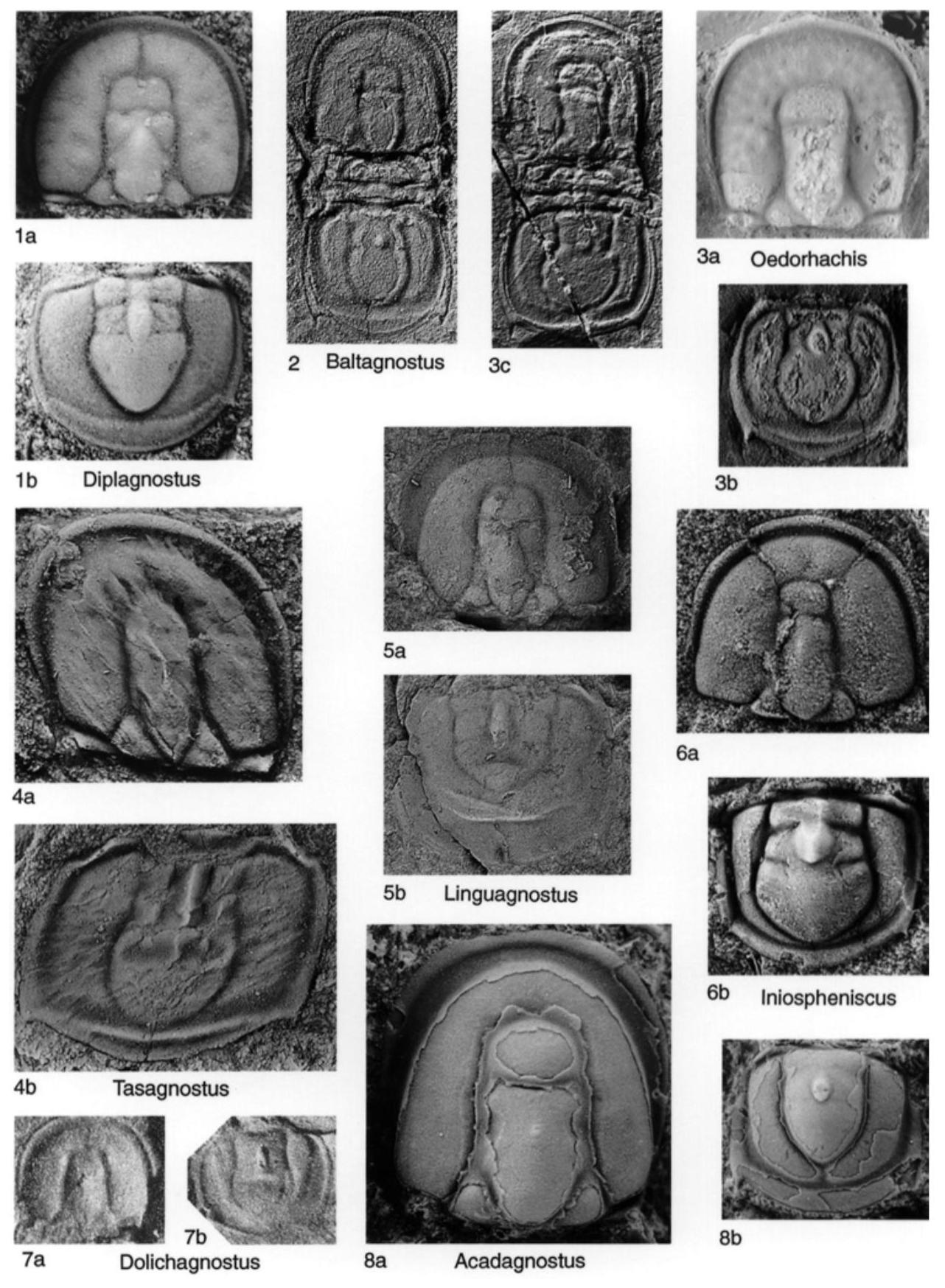Welcome to the Treatise on Invertebrate Paleontology!
Please enter a genera name to retrieve more information.

Oedorhachis
Classification
Phylum:
Arthropoda
Class:
Trilobita
Order:
Agnostida
Superfamily:
Agnostoidea
Family:
Diplagnostidae
Formal Genus Name and Reference:
Oedorhachis RESSER, 1938, p. 50
Type Species:
*O. typicalis; OD; holotype (RESSER, 1938, pl. 10, fig. 16, 22, 28), 94866, USNM, Washington, D.C.
Images
(Click to enlarge in a new window)
Fig. 230,3a–c. *O. typicalis; a,b, upper Middle Cambrian (Lejopyge laevigata Zone), northern Greenland (Gustav Holm Dal, Peary Land); a, cephalon, MGUH 17.115, ×8, b, pygidium, MGUH 17.118, ×8 (Robison, 1988, fig. 4, 8.1); c, Late Cambrian (Dresbachian, Crepicephalus Zone), USA (Cedar Bluff, Alabama), holotype, exoskeleton, USNM 94866, ×6 (new).
Synonyms
Geographic Distribution
northern Greenland; ? Sweden; Australia (Queensland), G. nathorsti to A. quasivespa Zones; Argentina, Bolaspidella Zone; Canada (Northwest Territories), Cedaria minor Zone; USA (Alabama, Tennessee), G. stolidotus Zone; China (Liaoning, Qinghai), Blackwelderia Zone.
Age Range
Beginning Stage in Treatise Usage:
upper Middle Cambrian
Beginning International Stage:
Drumian
Fraction Up In Beginning Stage:
0
Beginning Date:
504.5
Ending Stage in Treatise Usage:
lower Upper Cambrian
Ending International Stage:
Jiangshanian
Fraction Up In Ending Stage:
25
Ending Date:
493.4
Description
Similar to Tasagnostus but with incipient zonation only and lacking transverse furrow in posterior pygidial axial lobe.
References
Museum or Author Information
Classification
Phylum:
Arthropoda
Class:
Trilobita
Order:
Agnostida
Superfamily:
Agnostoidea
Family:
Diplagnostidae
Formal Genus Name and Reference:
Oedorhachis RESSER, 1938, p. 50
Type Species:
*O. typicalis; OD; holotype (RESSER, 1938, pl. 10, fig. 16, 22, 28), 94866, USNM, Washington, D.C.
Images
(Click to enlarge in a new window)
Fig. 230,3a–c. *O. typicalis; a,b, upper Middle Cambrian (Lejopyge laevigata Zone), northern Greenland (Gustav Holm Dal, Peary Land); a, cephalon, MGUH 17.115, ×8, b, pygidium, MGUH 17.118, ×8 (Robison, 1988, fig. 4, 8.1); c, Late Cambrian (Dresbachian, Crepicephalus Zone), USA (Cedar Bluff, Alabama), holotype, exoskeleton, USNM 94866, ×6 (new).
Synonyms
Geographic Distribution
northern Greenland; ? Sweden; Australia (Queensland), G. nathorsti to A. quasivespa Zones; Argentina, Bolaspidella Zone; Canada (Northwest Territories), Cedaria minor Zone; USA (Alabama, Tennessee), G. stolidotus Zone; China (Liaoning, Qinghai), Blackwelderia Zone.
Age Range
Beginning Stage in Treatise Usage:
upper Middle Cambrian
Beginning International Stage:
Drumian
Fraction Up In Beginning Stage:
0
Beginning Date:
504.5
Ending Stage in Treatise Usage:
lower Upper Cambrian
Ending International Stage:
Jiangshanian
Fraction Up In Ending Stage:
25
Ending Date:
493.4
Description
Similar to Tasagnostus but with incipient zonation only and lacking transverse furrow in posterior pygidial axial lobe.
